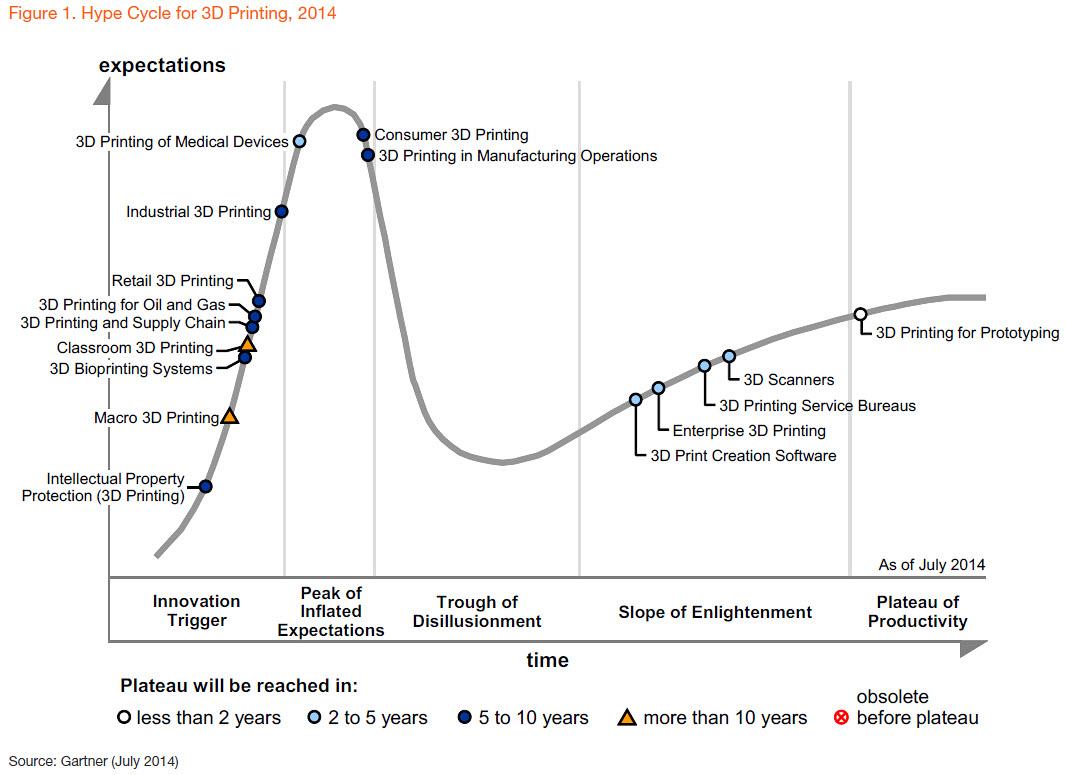Market leading IT research and advisory firm, Gartner, suggests a minimum of five to ten years for the consumer level adoption of 3D printing. This timeline is inline with many expert predictions on the highly anticipated boom in home based 3D printing.
“Consumer 3D printing is around five to ten years away from mainstream adoption,” said Pete Basiliere, research vice president at Gartner. “Today, approximately 40 manufacturers sell the 3D printers most commonly used in businesses, and over 200 startups worldwide are developing and selling consumer-oriented 3D printers, priced from just a few hundred dollars. However, even this price is too high for mainstream consumers at this time, despite broad awareness of the technology and considerable media interest.”
In their report titled “Hype Cycle for 3D Printing, 2014” (which is available on Gartner’s website), Gartner sets out their predictions for the development of a technology which promises so many applications. While suggesting that home consumers may need to be patient in the wait for a practical and affordable 3D printer, Gartner believes that medical and business applications will drive the industry in the coming years. The study consulted organizations from across the sector, be it technology providers, government agencies, current users or educational and financial institutions. From this broad research, two main themes emerged.
First were the stark differences between the enterprise 3D printing market and the consumer 3D printing market. Although some companies are minimizing risk and capital investment by acquiring consumer devices to discover the potential benefits of 3D printing for their business, that is really where the similarities end. Essentially, the 3D printing industry needs to have a completely different approach in order to significantly penetrate the consumer market and this approach will take time to develop.
Secondly, 3D printing is currently not one technology but seven different technologies. Gartner’s Basiliere suggests. “Hype around home use obfuscates the reality that 3D printing involves a complex ecosystem of software, hardware and materials whose use is not as simple to use as ‘hitting print’ on a paper printer. The seven different technologies each have pros and cons, and printers work with varying build sizes and materials. This means organizations must begin with the end products in mind.”
Similar to the emergence of many technologies in recent decades, 3D printing needs to determine the specific consumer demands, in order to develop a practical and affordable technology. Basiliere recommends the industry should “First, determine the material, performance and quality requirements of the finished items; second, determine the best 3D printing technology; and third, select the right 3D printer.”
The report may disappoint many consumers and retailers eagerly awaiting the age where home based 3D printing is commonplace. However, most will accept that the complexity that still exists with the technology must be overcome first. We can all rest assured that 3D printing’s commercial potential will ensure that all industry forces will be pushing in the same direction; to make consumer 3D printing a reality as soon as possible.
What do you think about Gartner’s report? Do you agree that 3D printing is still several years off from being commonplace in homes? Discuss in the Gartner Consumer 3D Printing Report forum thread on 3DPB.com.
Subscribe to Our Email Newsletter
Stay up-to-date on all the latest news from the 3D printing industry and receive information and offers from third party vendors.
You May Also Like
Profiling a Construction 3D Printing Pioneer: US Army Corps of Engineers’ Megan Kreiger
The world of construction 3D printing is still so new that the true experts can probably be counted on two hands. Among them is Megan Kreiger, Portfolio Manager of Additive...
US Army Corps of Engineers Taps Lincoln Electric & Eaton for Largest 3D Printed US Civil Works Part
The Soo Locks sit on the US-Canadian border, enabling maritime travel between Lake Superior and Lake Huron, from which ships can reach the rest of the Great Lakes. Crafts carrying...
Construction 3D Printing CEO Reflects on Being Female in Construction
Natalie Wadley, CEO of ChangeMaker3D, could hear the words of her daughter sitting next to her resounding in her head. “Mum, MUM, you’ve won!” Wadley had just won the prestigious...
1Print to Commercialize 3D Printed Coastal Resilience Solutions
1Print, a company that specializes in deploying additive construction (AC) for infrastructure projects, has entered an agreement with the University of Miami (UM) to accelerate commercialization of the SEAHIVE shoreline...






























